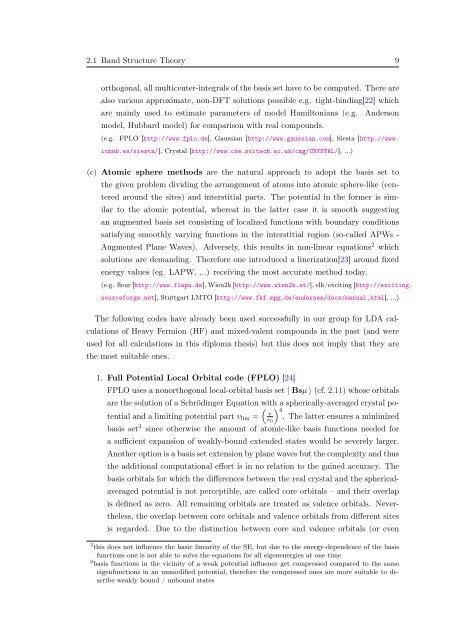Diploma - Max Planck Institute for Solid State Research
Diploma - Max Planck Institute for Solid State Research
Diploma - Max Planck Institute for Solid State Research
Create successful ePaper yourself
Turn your PDF publications into a flip-book with our unique Google optimized e-Paper software.
2.1 Band Structure Theory 9<br />
orthogonal, all multicenter-integrals of the basis set have to be computed. There are<br />
also various approximate, non-DFT solutions possible e.g. tight-binding[22] which<br />
are mainly used to estimate parameters of model Hamiltonians (e.g.<br />
model, Hubbard model) <strong>for</strong> comparison with real compounds.<br />
Anderson<br />
(e.g. FPLO [http://www.fplo.de], Gaussian [http://www.gaussian.com], Siesta [http://www.<br />
icmab.es/siesta/], Crystal [http://www.cse.scitech.ac.uk/cmg/CRYSTAL/], ...)<br />
(c) Atomic sphere methods are the natural approach to adopt the basis set to<br />
the given problem dividing the arrangement of atoms into atomic sphere-like (centered<br />
around the sites) and interstitial parts. The potential in the <strong>for</strong>mer is similar<br />
to the atomic potential, whereat in the latter case it is smooth suggesting<br />
an augmented basis set consisting of localized functions with boundary conditions<br />
satisfying smoothly varying functions in the interstitial region (so-called APWs -<br />
Augmented Plane Waves). Adversely, this results in non-linear equations 2 which<br />
solutions are demanding. There<strong>for</strong>e one introduced a linerization[23] around fixed<br />
energy values (eg. LAPW, ...) receiving the most accurate method today.<br />
(e.g. fleur [http://www.flapw.de], Wien2k [http://www.wien2k.at/], elk/exciting [http://exciting.<br />
source<strong>for</strong>ge.net], Stuttgart LMTO [http://www.fkf.mpg.de/andersen/docs/manual.html], ...)<br />
The following codes have already been used successfully in our group <strong>for</strong> LDA calculations<br />
of Heavy Fermion (HF) and mixed-valent compounds in the past (and were<br />
used <strong>for</strong> all calculations in this diploma thesis) but this does not imply that they are<br />
the most suitable ones.<br />
1. Full Potential Local Orbital code (FPLO) [24]<br />
FPLO uses a nonorthogonal local-orbital basis set | Bsµ 〉 (cf. 2.11) whose orbitals<br />
are the solution of a Schrödinger Equation with a spherically-averaged crystal potential<br />
and a limiting potential part v lim =<br />
(<br />
r<br />
r 0<br />
) 4.<br />
The latter ensures a minimized<br />
basis set 3 since otherwise the amount of atomic-like basis functions needed <strong>for</strong><br />
a sufficient expansion of weakly-bound extended states would be severely larger.<br />
Another option is a basis set extension by plane waves but the complexity and thus<br />
the additional computational ef<strong>for</strong>t is in no relation to the gained accuracy. The<br />
basis orbitals <strong>for</strong> which the differences between the real crystal and the sphericalaveraged<br />
potential is not perceptible, are called core orbitals – and their overlap<br />
is defined as zero. All remaining orbitals are treated as valence orbitals. Nevertheless,<br />
the overlap between core orbitals and valence orbitals from different sites<br />
is regarded. Due to the distinction between core and valence orbitals (or even<br />
2 this does not influence the basic linearity of the SE, but due to the energy-dependence of the basis<br />
functions one is not able to solve the equations <strong>for</strong> all eigenenergies at one time<br />
3 basis functions in the vicinity of a weak potential influence get compressed compared to the same<br />
eigenfunctions in an unmodified potential, there<strong>for</strong>e the compressed ones are more suitable to describe<br />
weakly bound / unbound states
















